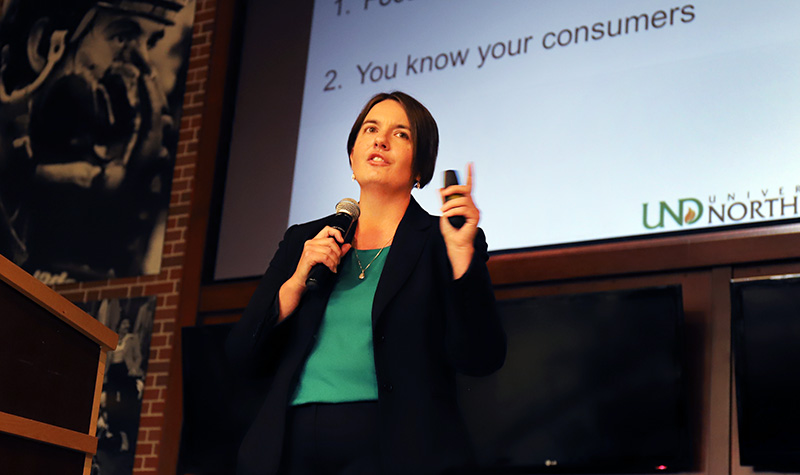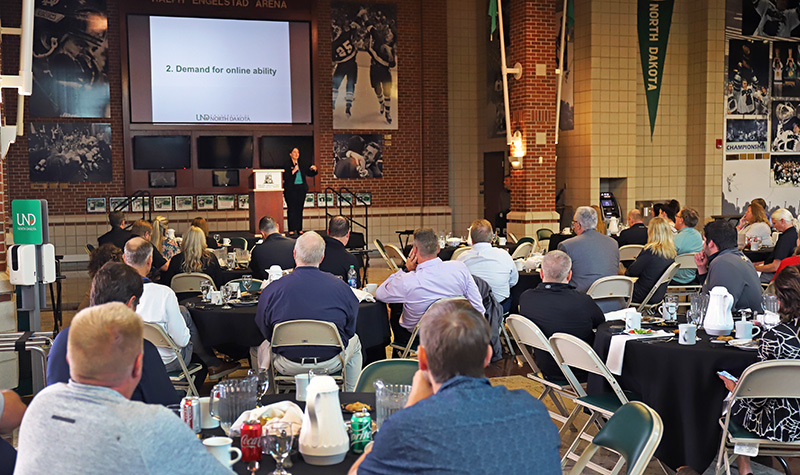Marketing in the age of COVID
UND consumer behavior researcher provides business tips on marketing

Jennifer Stoner’s specialty is researching consumer behavior to determine how and why people make the buying decisions they do.
“At some point in my life, I became curious about why people do the strange things they do,” explained the UND associate professor of marketing in the Nistler College of Business & Public Administration. “Why do people name their cars? Why do North Dakotans put pickles in their beer?”
Growing up in Pennsylvania, Stoner was inadvertently introduced to consumer behavior by her father, who worked in sales and marketing for a hardware company. She sometimes accompanied him to the big box home improvement stores to observe what their customers bought.
“Were they looking at specific features or just looking at the price and moving on?” she said. “My dad was a consumer behaviorist, but he didn’t know it at the time.”
In the wake of the COVID pandemic and the relaxing of restrictions in some areas, new challenges have emerged in which marketing has become a moving target as daily developments influence consumers’ decisions in unexpected ways. Businesses are looking for answers on how to deal with changes in the attitudes and buying habits of their customers.
Pop goes the marketing landscape

Stoner describes this new landscape as being similar to a game called “Perfection.” Players try to beat a timer as they fit different-shaped pieces into corresponding openings on a gameboard. When time runs out, there’s a pop that sends the pieces flying in all directions.
“Now we’re trying to fit all those pieces back in there,” she said. “Have some pieces gone away completely? Are they going to come back in the same places? Or is everything going to be slightly different?”
Part of the challenge is understanding the difference between peoples’ intentions and their behavior.
“People might intend to continue habits they developed during the pandemic, but they’re also pretty bad at actually predicting their own behavior,” she said. “Intentions are different from behavior. My prediction is that life is going to interrupt whatever their great intentions were for doing something – similar to keeping New Year’s resolutions.”
The trend toward more online shopping is an example of changing consumer behavior. In 2019, Stoner said fewer than 40% of people surveyed had purchased groceries online. By 2020, it was above 50% and is expected to surpass 60% by the end of 2021.
“I’m not saying all those people are going to continue buying groceries online,” she said. “What I’m saying is they’re now comfortable with the idea. If it’s more convenient to do so when it’s 20 below zero outside and they really don’t want to go out, they may choose to continue to use the online service.”
Marketing tips for business
Stoner offered insight in six key areas she believes can help businesses with marketing in the era of COVID.
The importance of experiences
“We know millennials are experiential, meaning they want to spend their money on experiences rather than stuff,” Stoner said. “That was taken away from them during the pandemic. They couldn’t go to the big game. They couldn’t go on that honeymoon trip or to the big 30th birthday party. When these experiences are taken away, they either want them more or decide their lives are okay without them.
“In contrast, baby boomers were faced with their own mortality during the pandemic by constantly being reminded they were at risk. They realized that tomorrow was no longer guaranteed. All the plans they were making – going to visit the grandkids or taking a trip overseas to explore family heritage or buying a boat – they decided they needed to do it now. They want experiential events in their lives as well.”

Demand for online ability
“There are two things you can do,” Stoner explained. “One is to continue offering whatever convenience you offered before or during the pandemic. If you’re offering certain services that people can do online, continue to offer them.
“If you want people back in your business, remind them of how it’s different and how it’s better. For example, I was doing workouts on YouTube, but there are benefits to actually being in a room where there’s an instructor pushing me and I’m not worried about running into my kitchen counter. Communicate why it’s important and why it’s better for your customers to be there in person.”
Diffusion of brand loyalty
“People are often very loyal to one brand, but COVID has disrupted this,” Stoner said. “Now they’re loyal to two brands or maybe a subset of brands. One study found that 30-40% of consumers want to continue to switch brands. Even when their name brand is available, they’ll continue to switch back and forth.
“There are two types of brand loyalty. The first one is called attitudinal loyalty. This is where someone feels strongly connected to a brand because it says something about who they are. The second type of loyalty is behavior loyalty. Categories like toothpaste, dish detergent and toilet paper tend to have behavioral loyalty.
“For attitudinal loyal customers strongly connected to your brand, they’re ready to come back when you’re ready for them. All you have to do is reconnect with them, reach out to them, and they’ll be ready to come back.
“With behavioral loyalty customers, you’ll want to differentiate from your competitors. Remind them why you’re better and why they should be with your company or with your brand. Try to reach out to them and build a relationship with stronger connections for the future.”
Focus on hygiene and cleanliness
“There’s a study showing that 85% of consumers say visible cleaning mechanisms are important to them,” Stoner said. “They want to see a business in a setting that looks clean. When we think about hygiene and cleanliness, we think about sanitizer stations and wipes to clean the grocery cart. I do think this this will eventually go away – depending on what happens with the pandemic. But for the near future, consumers are still going to want that reassurance that it’s safe to be working with your business.”
Decrease in basket size
“During the pandemic, there was a decrease in the number of things people purchased at one time,” Stoner noted. “This was happening because of the empty shelves and people were stocking up on stuff when they could get it. But as people have been going back to work, they’ve gone back to doing more convenience shopping – picking up items on their way home from work.
“People are still thinking about scarcity. It’s still at the top of their mind. If we start to see supply-side shocks because of the pandemic or supply chain delays or environmental issues or a breakdown in trade relations – especially around the holiday season. People will fairly quickly revert back to buying all the things they can while they can.
“If you have new products or a product that’s been unavailable or out of stock, promote them because it’s something your customers aren’t going to have stockpiled. These are things they can get their hands on.”
Intention to keep new habits and hobbies
“A lot of people tried new stuff during the pandemic and realized they liked it,” according to Stoner. “Some people started doing puzzles, baking bread or making craft cocktails. Other people found they liked the outdoors and were going out hiking or playing golf more. There’s an intention to continue to do that. I do think these will last longer because people have been doing them for more than a couple months, and it’s more of a habit now.”
Use what you know
Stoner encourages business owners to use their knowledge of their employees, their customers and the types of businesses they run to guide them in making marketing decisions. She uses her recent experience with UND students the classroom as an example.
“Many of our seniors still want to be online because they might have moved home during the pandemic,” she said. “Some have started jobs and realized that they’re going to finish their last semester or two online. They can save some money and maybe make some money at the same time.
“However, juniors and below really want to be in the classroom,” she continued. “They are super-excited to be back in the classroom. They’re more engaged than I’ve ever seen students here before.
“You may have similar customer segments: some of them want to be online while some may want face-to-face interaction and be excited about it,” she concluded.



